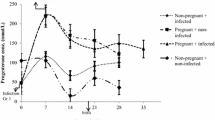Abstract
Parasitic infections can have detrimental effects on the reproductive capacity of their hosts. Infections by the cestode Taenia pisiformis in rabbits is generally not associated with increased mortality of offspring or with loss of maternal body condition but can result in reduced fecundity, and increased circulating progesterone levels have been reported in infected does compared to uninfected ones. In the present study, the possibility that T. pisiformis infection affects fecundity by reducing embryonic implantation was examined. Seven anesthetized New Zealand does were orally infected with 1000 eggs of T. pisiformis, and seven were administered saline. Seven weeks after infection, does were mated, and 7 days after, humanely sacrificed. A decrease in the number of implanted embryos and a decrease in the size of the embryo vesicles in infected does were observed (P ≤ 0.02, Student’s t-test). There was a negative correlation between the number of hepatic granulomas and embryo implantation (ρ = − 0.8, P = 0.04, Spearman’s test).


Similar content being viewed by others
Data availability
All data generated or analyzed during this study are included in this published article.
References
Arteaga-Silva M, Vargas-Villavicencio JA, Vigueras-Villaseñor RM, Rodríguez-Dorantes M, Morales-Montor J (2009) Taenia crassiceps infection disrupts estrous cycle and reproductive behavior in BALB/c female mice. Acta Trop 109:141–145
Cai Q, Wan F, Appleby D, Hu L, Zhang H (2014) Quality of embryos transferred and progesterone levels are the most important predictors of live birth after fresh embryo transfer: a retrospective cohort study. J Assist Reprod Genet 31(2):185–194
Chaouat G, Dubanchet S, Ledée N (2007) Cytokines: important for implantation? J Assist Reprod Genet 24(11):491–505
Fischer B, Chavatte-Palmer P, Viebahn C, Navarrete Santos A, Duranthon V (2012) Rabbit as a reproductive model for human health. Reproduction 144(1):1–10
Gomez de Leon CT, Ostoa-Saloma P, Segovia-Mendoza M, Del Rio-Araiza VH, Morales-Montor J (2021) Environmental parasitology and its impact on the host neuroimmunoendocrine network. Front Biosci (Landmark Ed) 26(3):431–443
Hallal-Calleros C, Morales-Montor J, Orihuela-Trujillo A, Togno-Peirce C, Murcia-Mejía C, Bielli A, Hoffman-Kurt L, Flores-Pérez FI (2016) Taenia pisiformis cysticercosis induces decreased prolificacy and increased progesterone levels in rabbits. Vet Parasitol 229:50–53
Kasilima YS, Wango EO, Kigondu CS, Mutayoba BM, Nyindo M (2004) Plasma bioactive LH and testosterone profiles in male New Zealand rabbits experimentally infected with Schistosoma mansoni. Acta Trop 92(3):165–72
Khan-Dawood FS, Dawood MY (1984) Implantation of the rabbit blastocyst: sequential changes in estradiol and progesterone and their receptors. AJOG 150(5):450–455
Morales J, Arteaga M, Romano MC, Larralde C, Morali G (1996) Changes in sexual behavior in male mice produced by chronic infection with Taenia crassiceps cysticerci. J Parasitol 85(5):689–693
Percie du Sert N, Ahluwalia A, Alam S, Avey MT, Baker M et al (2020) Reporting animal research: explanation and elaboration for the ARRIVE guidelines 2.0. PLoS Biol 18(7):e3000411. https://doi.org/10.1371/journal.pbio.3000411
Schenke C, Rojas M, Del Sol M (2008) Morphometric evaluation of the embryo-uterine relationship of the pre and post implantational stages in rabbit (Oryctolagus cuniculus). Int J Morphol 26(4):995–1004
Sterz H, Nothdurft H, Lexa P, Ockenfels H (1987) Teratologic studies on the Himalayan rabbit: new aspects of thalidomide-induced teratogenesis. Arch Toxicol 60(5):376–381
Szkucik K, Pyz-Łukasik R, Szczepaniak KO, Paszkiewicz W (2014) Occurrence of gastrointestinal parasites in slaughter rabbits. Parasitol Res 113:59–64
Acknowledgements
DRR (273755), AHD (492304), and DGE (305290) acknowledge the PhD fellowships received from Consejo Nacional de Ciencia y Tecnología. The authors acknowledge the technical support from Erika Segura Salinas and to Dr. Kurt L Hoffman and Dr. Irene Lee Rivera for a thorough review of the grammar and other language issues.
Author information
Authors and Affiliations
Contributions
Hallal-Calleros C. and Flores-Perez I. conceived and designed the research; Dominguez-Roldan R., Arias Hernández D. and Dunstand-Guzman E. performed the research and acquired the data; Dominguez-Roldan R, Sciutto E. and Aguirre-Flores V. analyzed the data; Hallal-Calleros C. and Flores-Perez I. interpreted the data and drafted the manuscript. All authors revised and approved the manuscript.
Corresponding authors
Ethics declarations
Competing interests
The authors declare no competing interests.
Ethics approval
Ethical approval was waived by the local Ethics Committee of Autonomous University of Morelos State (Internal committee of bioethics in animal research, permit number 42022). Animal care and all experimental practices were performed in strict accordance with recommendations of international standards (Percie du Sert et al. 2020).
Consent for publication
All authors approve the publication of this manuscript.
Additional information
Handling Editor: Una Ryan
Publisher's note
Springer Nature remains neutral with regard to jurisdictional claims in published maps and institutional affiliations.
Rights and permissions
Springer Nature or its licensor (e.g. a society or other partner) holds exclusive rights to this article under a publishing agreement with the author(s) or other rightsholder(s); author self-archiving of the accepted manuscript version of this article is solely governed by the terms of such publishing agreement and applicable law.
About this article
Cite this article
Rosa, DR., David, AH., Emmanuel, DG. et al. Decreased embryo implantation in rabbits infected with Taenia pisiformis. Parasitol Res 121, 3689–3692 (2022). https://doi.org/10.1007/s00436-022-07694-2
Received:
Accepted:
Published:
Issue Date:
DOI: https://doi.org/10.1007/s00436-022-07694-2




